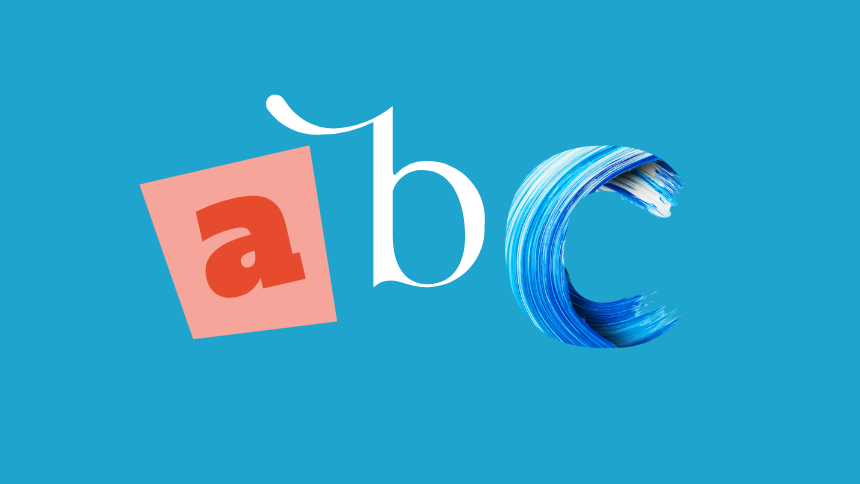Maîtriser l'art de la typographie
La typographie joue un rôle crucial dans la définition de l’identité d’une marque et dans la communication de sa personnalité auprès du public. Choisir la police idéale nécessite une réflexion minutieuse, car elle peut influencer la perception de votre marque. Dans cet article, nous explorerons des techniques pour vous aider à naviguer dans le vaste monde de la typographie et choisir la police idéale pour votre marque.
- Comprendre la personnalité de votre marque : avant de plonger dans le monde des polices, il est essentiel d’avoir une compréhension claire de la personnalité et des valeurs de votre marque. Visez-vous un aspect moderne et sophistiqué, ou votre marque dégage-t-elle une atmosphère plus ludique et informelle ? Aligner votre typographie avec la personnalité de votre marque est la première étape pour créer une identité visuelle cohérente.
- Penser à la lisibilité et à la clarté : la lisibilité de votre texte est primordiale. Choisissez une police facile à lire sur différentes plateformes et tailles. Considérez la lisibilité du texte principal et des titres, en vous assurant que votre public peut absorber facilement le message de votre marque sans effort.
- Connaître les catégories de polices : familiarisez-vous avec différentes catégories de polices, telles que les polices avec empattement (serif), sans empattement (sans-serif), manuscrites (script), et décoratives (display). Chaque catégorie a ses propres caractéristiques et évoque des émotions spécifiques. Par exemple, les polices serif sont souvent associées à la tradition et à la fiabilité, tandis que les polices sans-serif sont liées à la modernité et à la simplicité.
- Penser à la polyvalence : optez pour une police polyvalente adaptée à diverses applications. Une police qui fonctionne bien aussi bien en numérique qu’en impression assure une cohérence sur différents supports. Considérez comment la police apparaîtra à différentes tailles et poids pour maintenir la cohérence visuelle de votre marque.
- Associer les polices de manière réfléchie : si votre marque nécessite plusieurs polices, assurez-vous qu’elles se complètent harmonieusement. Choisissez des polices qui créent une combinaison équilibrée et visuellement attrayante. Associer une police audacieuse pour les titres accrocheurs avec une police plus neutre et facile à lire pour le texte principal est une stratégie courante.
- Tester pour l’accessibilité : l’accessibilité est une considération cruciale dans le paysage numérique actuel. Assurez-vous que votre police choisie respecte les normes d’accessibilité, offrant clarté et lisibilité aux personnes ayant des troubles visuels. Vérifiez le contraste des couleurs et la taille de la police pour améliorer l’accessibilité auprès d’un public diversifié.
- Maintenir la cohérence à travers les éléments de la marque : la cohérence est la clé pour construire une marque forte et reconnaissable. Une fois que vous avez choisi votre typographie, maintenez la cohérence à travers tous les éléments de la marque, y compris votre site web, vos supports marketing et vos plateformes de médias sociaux. Cette uniformité renforce l’identité de votre marque dans l’esprit de votre public.
- Explorer la typographie personnalisée : Pour une identité de marque vraiment unique et distinctive, envisagez d’investir dans une typographie personnalisée. Adapter une police pour correspondre parfaitement à votre marque peut vous démarquer de la concurrence et renforcer la reconnaissance de la marque.
Choisir la typographie parfaite pour votre marque est un processus nuancé qui nécessite un mélange réfléchi d’esthétique, de fonctionnalité et de personnalité de la marque. En comprenant votre marque, en considérant la lisibilité, en explorant les catégories de polices et en maintenant la cohérence, vous pouvez prendre des décisions éclairées qui contribuent à une identité visuelle forte et mémorable. Maîtriser l’art de la typographie est un outil puissant pour créer une impression durable et positive auprès de votre public.
Les bonnes pratiques et les erreurs à éviter en matière de branding
Construire une marque solide nécessite du temps, des efforts et une planification minutieuse. En tant que propriétaire d’une petite entreprise, il est essentiel d’aborder le branding de manière stratégique et d’éviter les erreurs courantes qui pourraient compromettre vos efforts. Voici quelques bonnes pratiques et erreurs à éviter à garder à l’esprit lors de la construction de votre marque :
À faire :
1. Définir votre proposition de valeur unique utilisez-la pour orienter vos messages et vos efforts marketing.
2. Investir dans un branding visuel de qualité : cela inclut un logo bien conçu, une palette de couleurs et une typographie soignée.
3. Prioriser la cohérence : assurez-vous que tous les aspects de votre branding, du message à l’identité visuelle, soient cohérents.
À éviter :
1. Essayer de plaire à tout le monde : concentrez-vous sur votre public cible et créez des messages qui répondent directement à leurs besoins.
2. Négliger votre présence en ligne : dans l’ère numérique d’aujourd’hui, votre site web et vos comptes sur les réseaux sociaux sont souvent la première impression que vous laissez à vos clients potentiels.
3. Avoir peur d’évoluer : n’hésitez pas à faire évoluer votre branding au fil du temps. Il doit suivre la croissance et les changements de votre entreprise.
Dans notre agence de marketing numérique, nous sommes spécialisés dans l’aide aux petites entreprises pour développer et mettre en œuvre des stratégies de branding efficaces. Contactez-nous dès aujourd’hui pour découvrir comment nous pouvons vous aider à construire une marque qui génère de vrais résultats pour votre entreprise.
Rejoignez la communauté #NectarCollective
#NectarCollective est bien plus qu’un hashtag ; c’est une communauté d’entreprises engagées à prospérer à l’ère numérique. Partagez vos progrès, vos idées et vos succès sur les réseaux sociaux, et construisons ensemble un récit collectif de croissance et de réussite.
Decoding the Key Components of a Strong Brand Identity
In the digital realm, user experience (UX) and user interface (UI) design play a pivotal role in capturing and retaining users’ attention. Nectar understands the significance of UI/UX design and is here to shed light on its impact.
User-Centric Approach:
Design with the user in mind, prioritizing their needs and preferences.
Intuitive Navigation:
Create a seamless and intuitive flow that guides users through your website, social media or app.
Visual Consistency:
Maintain a consistent design language to create a cohesive and engaging experience.
Responsiveness:
Ensure your design is optimized for various devices and screen sizes.
Usability Testing:
Regularly test your design with real users to identify and address any pain points.
Ready to enhance your digital platforms with exceptional UI/UX design? Nectar can help you create user-friendly and visually appealing interfaces that leave a lasting impression. Contact us today to elevate your digital experience!
The Blueprint for a Consistently Powerful Brand Identity
Establishing a strong and consistent brand identity is key to building trust, recognition, and loyalty among your audience. A digital brand guidelines book serves as a comprehensive reference that outlines your brand’s visual and tonal guidelines, ensuring consistency across all marketing channels.
Define Your Brand’s Visual Identity
Start by defining your brand’s visual elements, including logo usage, typography, color palette, and imagery guidelines. Clearly communicate how these elements should be used across different mediums to maintain a cohesive brand image.
Establish Tonal Guidelines
Define your brand’s voice and tone to ensure consistent messaging across all communication channels. Outline guidelines for writing style, vocabulary, and tone of voice to reflect your brand’s personality and values consistently.
Provide Design Templates and Examples
Include design templates and examples within your digital brand guidelines book to guide designers and content creators. These templates can help maintain consistency in marketing collateral, social media posts, website layouts, and other visual assets.
Outline Usage Guidelines for Digital Platforms
Specify how your brand should be represented on various digital platforms such as social media, email marketing, and websites. Provide guidelines for profile pictures, cover photos, social media post layouts, and email templates to ensure consistent branding and a seamless customer experience.
Update and Distribute the Guidelines
Regularly review and update your digital brand guidelines book to reflect any changes in your brand strategy or visual identity. Make the guidelines easily accessible to your team members and stakeholders so they can refer to them consistently.
Let’s craft a digital brand guidelines book that serves as a blueprint for your brand’s success and witness the transformative impact on your brand identity.
From Groovy to Lit: The Evolution of Slang Words Across Generations
Slang words are a staple in modern language, but they are constantly evolving, especially across different generations. What was once considered cool and hip in the past is now outdated and even cringe-worthy. In this article, we’ll take a closer look at how slang words have evolved across generations and how brands can integrate them into their marketing strategies.
Slang Words Across Generations
Each generation has its own unique set of slang words that reflect its culture and experiences. For example, baby boomers used phrases like « groovy » and « far out » in the 1960s and 1970s, while Generation X popularized words like « rad » and « totally » in the 1980s and 1990s. Millennials, on the other hand, introduced words like « lit » and « on fleek » in the 2010s, while Gen Z has popularized terms like « stan » and « cancel » in recent years.
Brands that understand and integrate the latest slang words into their marketing strategies connect with their target audience in a more meaningful and authentic way.
Integrating Slang Words into Marketing Strategies
When it comes to integrating slang words into marketing strategies, it’s important to consider the target audience. For example, if a brand is targeting baby boomers, using phrases like « groovy » and « far out » may resonate with them. However, if a brand is targeting Gen Z, using terms like « dank » and “glow up » may be more effective.
Integration tips:
- Understand the target audience and the slang words they use.
- Use slang words in a natural and authentic way. Forced or awkward usage can backfire and make the brand seem out of touch.
- Stay up-to-date on the latest slang words and trends. Slang words are constantly evolving, so it’s important to stay current.
- Avoid using slang words that may be offensive or insensitive. Some slang words have negative connotations, so it’s important to be aware of their meanings and contexts.
- Test and measure the effectiveness of using slang words in marketing campaigns. This will help brands determine which words resonate with their target audience and which ones don’t.
Slang words are a dynamic aspect of language that evolves with each generation. Brands that understand and integrate the latest slang words into their marketing strategies can connect with their target audience in a more meaningful and authentic way.
The Future of Branding in a Digital World
The future of branding is becoming increasingly digital. Here are a few trends and predictions for what’s next in the world of digital branding:
1. Personalization:
As consumers become more accustomed to personalized experiences, brands will need to find new and innovative ways to tailor their messaging and offerings to individual customers.
2. Augmented Reality:
With the rise of AR technology, brands will have new opportunities to create immersive and interactive experiences that blur the lines between the physical and digital worlds.
3. Voice Search:
As more consumers rely on voice assistants like Siri and Alexa, brands will need to optimize their content and messaging for voice search queries.
4. Artificial Intelligence:
As AI technology continues to advance, brands will be able to leverage data and analytics to deliver highly targeted and personalized messaging and experiences to customers.
At our digital marketing agency, we stay on the cutting edge of emerging trends and technologies in digital branding. If you’re looking to future-proof your branding strategy and stay ahead of the curve, contact us today to learn how we can help.
Let us help you build a brand that’s ready for whatever the future holds.
Branding your business to success.
Branding is a crucial element for your businesses, as it helps to establish a unique identity and reputation in the market. It is the process of creating an image and perception of your company that sets it apart from competitors. In this article, we will discuss the essential elements of branding and how they can help your organization achieve your goals.
- Target audience: Understanding your target audience’s needs and desires is essential for creating a brand identity that resonates with them. You should tailor your brand’s messaging and image to meet the needs of your target audience.
- Logo: A well-designed logo is a symbol that represents your brand and helps to establish your identity. It should be distinctive, memorable, and easily recognizable.
- Messaging: Consistent messaging is vital for creating a brand identity that resonates with your target audience. It should reflect the values and personality of your brand and be consistent across all platforms.
- Social media: Social media is an essential tool for branding as it allows you to connect with your customers in real-time. Your brands can use social media platforms to showcase products and services and engage with your audience.
- Long-term investment: Branding is not a one-time event, but a continuous process. As your business evolves, your branding should also evolve to reflect these changes. Consistency and staying true to your core values are key to building a lasting brand.
Branding is an integral part of any successful business. It is a process of creating a unique identity and reputation that resonates with your target audience. Let’s build credibility, trust, and loyalty with your customers.







